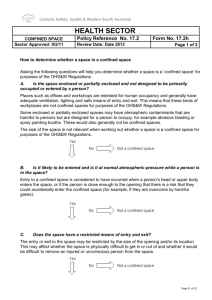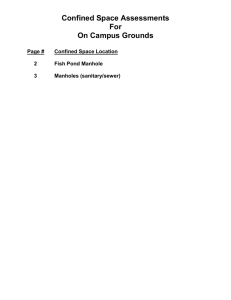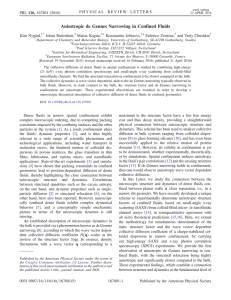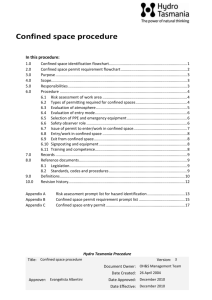CONFINED FLUIDS
advertisement
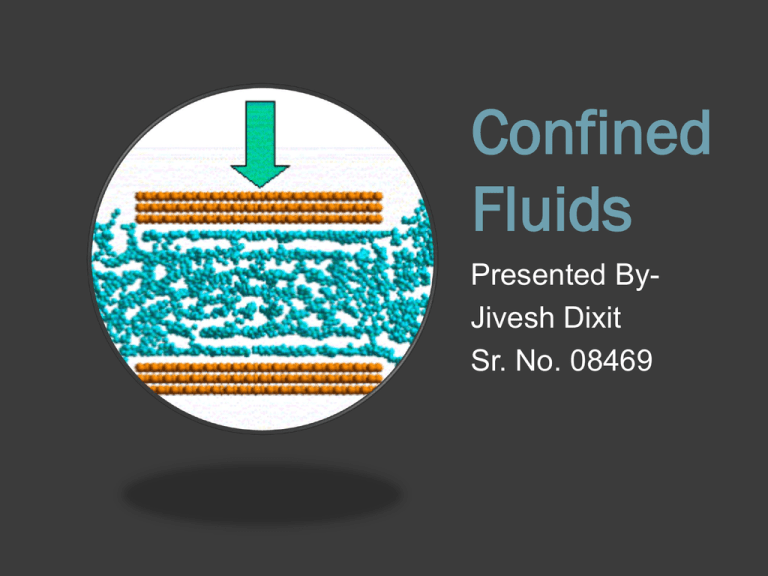
Confined Fluids Presented ByJivesh Dixit Sr. No. 08469 What are Confined Fluids? They are any fluids in a closed system. Confined fluids can move a round within the system, but they cannot enter or leave the system. When fluids are confined, they have some very interesting effects. Examples- The blood moving through your body is a confined fluid, the air in an air mattress, lubricant between mating parts, hydraulic or pneumatic braking system in vehicles etc. Confined Fluids in Tribology Understanding the atomic processes occurring at the interface of two dry or wet materials when they are brought together or moved with respect to one another is central to many technological problems in tribology, including adhesion, lubrication, friction, and wear. Example- Hydrodynamic Bearings, lubrication of mating parts in motion(sliding or rotating) etc. Introduction A central property of fluid confined between solid boundaries that are smooth on the molecular scale is their tendency to organize into layered structures. The mean local density oscillates with distance normal to the boundaries. Liquids confined in ultra-thin gaps may exhibit different mechanical responses. Schematic Illustration of a Confined Fluid Behavior of Confined Fluid in contact with the bulk under the effect of External Pressure Understanding the effect of external force on Confined Fluids (Particle Theory) The spaces between the particles are already very small. When an external force is applied, only a small decrease takes place in the liquid’s volume. In a gas, the particles are far apart from each other. In order for the force to be transmitted from one particle to another, the volume the gas occupies must be reduced. There is another effect that can occur when a force is applied to a gas or a liquid. Its state can be changed. Polar vs. Non Polar fluids If the fluid is such that the torques within it arise only as the moments of direct forces we shall call it nonpolar. A polar fluid is one that is capable of transmitting stress couples and being subjected to body torques, as in polyatomic and certain nonNewtonian fluids. Confined water controversies ( thin film of water between two solid boundaries) Water confined between the oscillating AFM tips and a single crystal (mica) shows progressively more sluggish mechanical relaxation as the film thickness decreases below 3–4 diameters of the water molecule. In this case a nonpolar fluid of compact shape, and reported a progressive dynamic slowdown upon increasing confinement between parallel single crystals (mica). Physical Behavior Confined fluids are neither like bulk fluids nor like bulk crystalline solids. They appear to be an intermediate kind of matter whose finite size and surface-fluid interactions impart unique structural, thermodynamic, and dynamic properties. Their inherently heterogeneous character and sluggish relaxation times are reminiscent of supercooled fluids. Hydrodynamic properties of Confined Fluids Boundary Conditions Any ‘microscopic’ BC reduces on a macroscopic scale to the no-slip BC. Simplest generalization of the no-slip BC that allows for a velocity slip at the fluid-wall interface: 𝜕𝑣𝛼 (𝑟, 𝑡) 1 = 𝑣𝛼 (𝑟, 𝑡)|𝑧=𝑧𝑤𝑎𝑙𝑙 (𝛼 = 𝑥, 𝑦) 𝜕𝑧 𝛿𝑤𝑎𝑙𝑙 Where; 𝑣(r, t)= velocity field, 𝛿𝑤𝑎𝑙𝑙 = slipping length, 𝑧𝑤𝑎𝑙𝑙 = location of hydrodynamic boundary Transport Properties The GK(Green–Kubo) relation for diffusion connects 𝐷∥ to the velocity autocorrelation function (ACF), +∞ 𝐷= 0 𝑑𝑡 < 𝑣𝑥 (𝑡)𝑣𝑥 (0) > < 𝑣𝑥 𝑡 𝑣𝑥 0 >∼ 𝑡 𝐷∥ −𝐷𝑏𝑢𝑙𝑘 𝐷𝑏𝑢𝑙𝑘 ℎ =− 𝐴𝑙𝑜𝑔 𝜎 +𝐵 ℎ 𝜎 −1 𝜋 2 exp(−υ( ) 𝑡) ℎ 1 + 𝒪( 2 ) ℎ Where, 𝐷∥ = diffusion constant(parallel to wall), 𝐷𝑏𝑢𝑙𝑘 = bulk diffusion constant, h= film thickness, 𝜎 = particle diameter, A,B= two (positive) numerical constants Questions & Comments Thank you for listening me



